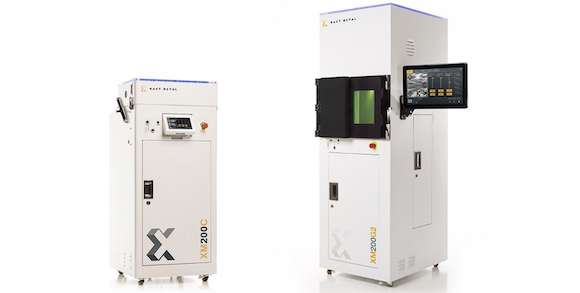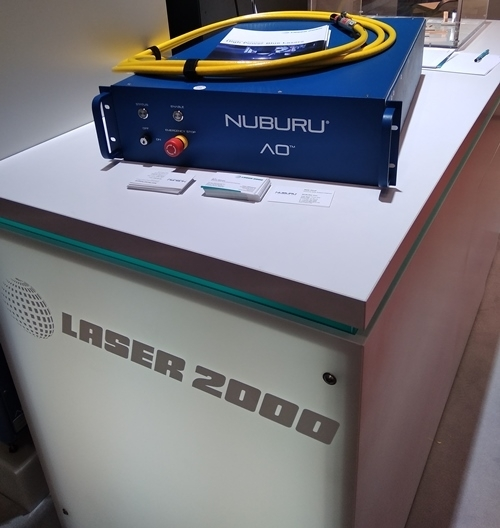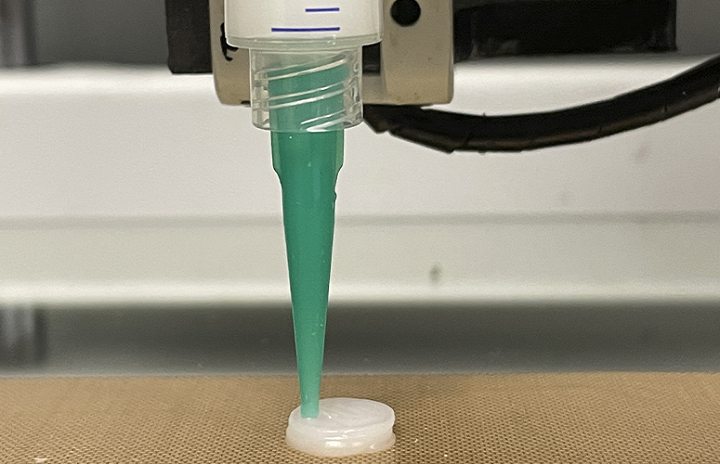In today’s 3D Printing News Briefs, we’ve got business stories to share, as Xact Metal has expanded to Latin America with two distribution partnerships, and NUBURU is looking to go public via a $330 million SPAC listing. Enable 3D and RWTH Aachen University published a white paper on direct-to-customer production via additive manufacturing, and Intech Additive Solutions collaborated with the Bhabha Atomic Research Centre to design and 3D print miniature metal components. Finally, researchers from Spain are 3D printing starch for the development of personalized medicine.
Xact Metal Announces Two Partnerships in Latin America

Xact Metal machines will be available in Mexico and Columbia through Tecnologías Computarizadas para Manufactura and USM Columbia
Pennsylvania-based metal AM startup Xact Metal announced that it is expanding its offering with two new sales and service distribution partnerships in Latin America. The first is with Tecnologías Computarizadas para Manufactura S.A. de C.V (TCM), based in Mexico, where there is a strong demand for affordable metal 3D printers, and the second is with USM Colombia. TCM, founded in 1996, originally worked with computer-assisted manufacturing equipment, but now offers a variety of high-end AM solutions, including plastic, resin, and metal, as well as software support. USM Colombia provides design solutions like 3D printers, 3D optical metrology, 3D scanning, and 3D modeling, and has distributed these solutions throughout the educational and industrial sectors since 2008.
“At Xact Metal, we’re committed to expanding the adoption and the democratisation of metal 3D printing by establishing a new level of price and performance in the industry. Increasing sales and service partnerships globally is key to the success of this mission, which is why we are excited to be growing across Latin America in exclusive partnerships with Tecnologías Computarizadas para Manufactura S.A. de C.V and USM Colombia,” stated Xact Metal CEO Juan Mario Gomez.
Blue Laser Specialist NUBURU Looking to Raise $330M in SPAC Deal

One of very few companies to be developing blue diode lasers for industrial applications, NUBURU is now hoping to raise in excess of $330 million through a SPAC merger deal.
NUBURU, which is based in Colorado, has pioneered the development of blue diode lasers, which have shorter wavelengths that make welding and 3D printing valuable applications. The company is now looking to go public and raise over $330 million via a merger with special-purpose acquisitions company (SPAC) Tailwind. The company is focused on expanding its distribution channels, growing its customer base, speeding up development of its 500 W laser product family, and scaling manufacturing operations to meet global demand. If Tailwind (TWND) and NUBURU stockholders give their final approval, the deal should be completed early next year, and it will become a publicly traded company under the ticker symbol URU. Tailwind CEO said NUBURU’s novel laser systems were akin to the “picks and shovels” used during the gold rush, except for aerospace, printing, consumer electronics, and e-mobility applications. In a message to shareholders and potential customers, Mark Zediker, CEO and Co-Founder of NUBURU, wrote the following:
“We carefully considered various options to best maximize Nuburu’s stockholder value, including raising new capital through private and traditional public market alternatives.
“After considering all of these avenues, we chose to pursue a SPAC process because it allows us to raise a substantial amount of capital quickly while fast tracking the path to being a public company and giving existing stockholders a clear path to achieve liquidity if you so desire.
“The proposed transaction will significantly enhance our ability to scale our technology and operations, and accelerate our growth.”
Enable 3D & RWTH Aachen Co-Publish White Paper
Together with the Machine Tool Laboratory (WZL) at RWTH Aachen University, Enable 3D has produced and published a white paper titled “Co-production: Direct-To-Customer by means of additive manufacturing,” which is now available for download. AM has been used in industrial production for a number of years now, but there are, as Enable 3D explained, “complex requirements” placed on the technology in these sectors. In the paper, Enable 3D and the WZL discuss AM opportunities in consumer production for industry and research, and note that involving customers in the process is often overlooked. But, as they explain, there are many advantages to co-production—for instance, in the case of Enable 3D, users can print out its accessories, lifestyle products, and storage solutions in the comfort of their own homes.
“Additive manufacturing is a trend that has already taken hold. At Enable 3D, we let users print out accessories themselves at home in cooperation with tool brands, among others,” explained Manuel Siskowski, Founder and CEO of Enable 3D. “Nevertheless, our approach is considered unusual in the tool industry. However, we receive encouragement from our customers, the 3D community and awards such as the German Innovation Award in Gold and know that we are on the right track. With our case study in the white paper, we would like to encourage other companies to take advantage of the opportunities additive manufacturing offers.”
Intech Additive Solutions & BARC 3D Printing Miniature Metal Components
Indian DfAM, software, and metal AM systems provider Intech Additive Solutions partnered with the Bhabha Atomic Research Centre (BARC), also in India, to design and 3D print miniature metal components, which can be used for critical applications in bio-robotics, such as cosmetic skin therapy and drug delivery. Intech Additive’s iFusion LF series can manufacture metal parts for industrial applications, and were designed to deliver high build rates and cost-effective manufacturing. BARC gave Intech Additive its initial designs, and the DfAM experts went to work, implementing modifications to further optimize the function of the components. Together, they 3D printed a metal, monolithic miniature component with a tapered front, cylindrical housing, and 33 mm length, that is meant to be assembled together with an end-cover part that’s 6.5 mm tall. The component’s completed assembly is now fully functional and, after further instrumentation, can be used for multiple applications.
In an appreciation letter to Intech Additive, Dr. Debanik Roy, Scientist, BARC Division of Remote Handling and Robotics, wrote, “In my opinion engineers at Intech have good acumen of technical brilliance, sense of practicality and leadership. I have observed that the engineers do follow ‘first principle thinking’, which is very essential for any indigenous out-of-the-box solution for new technology.
“I am proud to say that within a short span of six months, engineers of Intech have achieved the pinnacle of authentic product-oriented manufacturing with due persistence and passion.”
3D Printing Starch for Personalized Medicine

3D printing makes it possible to produce personalised drugs tailored to individual patients. (Image: UPV/EHU)
Researchers from the Materials+Technologies (GMT) Group at University of the Basque Country (UPV/EHU) are using 3D printing to create personalized, starch-based tablets that can help hydrophobic tailor drug release for specific patients with the right optimization of tablet shape and starch type. Detailing their work in a research paper, the team prepared non-soluble drug-loaded tablets based on one type of potato starch and two types of maize starch in different geometries. They performed a detailed rheological analysis to ensure that the materials would keep their shape once printed, and found that all did, though the potato starch tablet had a more “laborious” 3D printing process due to its natural properties. While more work is necessary, the team’s 3D printed starch-based medicines showed promise for personalized drug delivery.
“We observed the importance of the botanic origin of the starch in practically all the properties, such as porous microstructure, the formation of a stable network or the release of the drug. In the case of normal maize starch, drug release is instantaneous and the drug is fully released within 10 minutes; in the case of waxy maize starch and potato starch, release is more continuous and can take up to 6 hours for full release. We were also able to demonstrate the importance of tablet geometry in drug release,” explained GMT’s Kizkitza González, first author of the paper.
“Tablets combining different types of starch were also printed. In this case, release takes place in two stages. For example, in the case of an infection, in an initial stage using normal maize starch, a medicine could be released immediately to alleviate pain, and in a subsequent stage, with either of the other two types of starch, an antibiotic could be released more continuously.”
Subscribe to Our Email Newsletter
Stay up-to-date on all the latest news from the 3D printing industry and receive information and offers from third party vendors.
You May Also Like
Gorilla Sports GE’s First 3D Printed Titanium Cast
How do you help a gorilla with a broken arm? Sounds like the start of a bad joke a zookeeper might tell, but it’s an actual dilemma recently faced by...
Nylon 3D Printed Parts Made More Functional with Coatings & Colors
Parts 3D printed from polyamide (PA, Nylon) 12 using powder bed fusion (PBF) are a mainstay in the additive manufacturing (AM) industry. While post-finishing processes have improved the porosity of...
$25M to Back Sintavia’s Largest Expansion of Metal 3D Printing Capacity Since 2019
Sintavia, the digital manufacturing company specializing in mission-critical parts for strategic sectors, announced a $25 million investment to increase its production capacity, the largest expansion to its operations since 2019....
Velo3D Initiates Public Offering in a Bid to Strengthen Financial Foundations and Drive Future Growth
Velo3D (NYSE: VLD) has been among a number of publicly traded 3D printing firms that have attempted to weather the current macroeconomic climate. After posting a challenging financial report for 2023,...

































